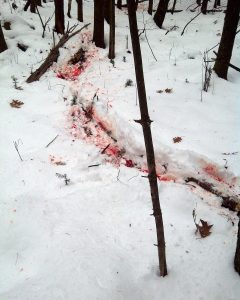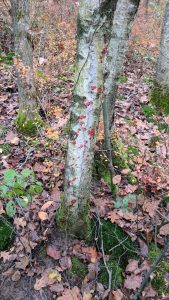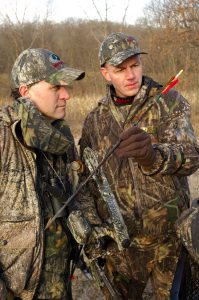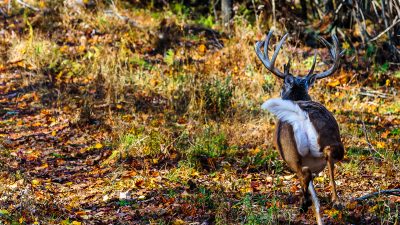So many factors can confound successfully recovering a wounded deer. Some are unavoidable, but many are preventable. How you prepare, and how you react all factor into blood trailing a deer to its logical conclusion.
Preventive Maintenance
The process of successful recovery begins long before the shot is taken. Before you even hit the woods, you need to be familiar, comfortable and proficient with your weapon of choice. That means practice, which is particularly important for the bowhunter. You’ll know you’ve achieved the proper proficiency when the shot becomes automatic, instinctive; you shouldn’t have to think about it. Muscle memory takes over and you only have to focus on the point of aim.
That brings us to the next element: proper shot placement. An entire article could be written on the topic but I’ll try and distill it down to basic guidelines. Of course, it varies with circumstance and choice of weapon. Firearms kill primarily through shock and trauma, while archery tackle kills with massive hemorrhaging (blood loss). In each case, you want to place the projectile where it will be most effective at its intended purpose, and where you feel most confident in our ability to do so.
For the archer, that’s the vitals, which means broadside, quartering away or slightly quartering-to. For the latter two, remember to consider and compensate for angles. Bowhunters sometimes get too focused on the “sweet spot” and end up hitting too far forward on deer that are quartering away.

Linda ARndt
Firearms hunters have more options. Obviously, a bullet to the vitals will kill a deer. Another popular option is the brachial plexus or high shoulder shot. When properly placed, it will cause major trauma to the front shoulders and spine and typically drops the deer on the spot. However, you have less margin for error so if you’re not familiar with deer anatomy and capable of accurate placement, don’t take it. Much the same logic applies to a neck or spine shot. You’ve got to be certain you will hit it.
At the Shot

Bob Humphrey
Next comes the actual process of shooting, and patience and composure are key. The adrenaline rush is part of why we hunt but you need to learn how to control it as anxiety affects accuracy. Calm yourself and wait for a clear shot. With experience, you’ll develop an instinct where you know when the shot is right, and almost immediately after, whether the shot was good or not. If there’s any doubt, assume it wasn’t.
A blood-stained arrow or blood sign at the hit site is generally good news. The brighter red the blood the better. The heart pumps oxygenated blood away from the heart-lung area through the arteries, so arterial blood is bright red. It also indicates a deeper wound. Frothy blood – with lots of air bubbles – could mean a lung hit. Blood flowing to the heart tends to be darker red as it is oxygen-depleted. Dark red blood could mean a superficial or muscular hit, which is not necessarily bad, if there’s a lot. Dark red blood can also mean a liver hit, which is usually fatal, but you’ll need to give it some time.
After the Shot
Before you take a single step you should be able to answer several questions.
-
Where was the deer standing when you shot?
Knowing where to pick up the trail can save valuable time. This location can also provide valuable clues as to how and when to proceed. Identify a particular feature or landmark from your stand before proceeding. If you’re hunting from an elevated stand, things look very different on the ground.
-
How did the deer react?
This too can provide clues to where you hit, but should be considered more of a guideline than a rule. An immediate response with the deer bolting could be a good hit or a clean miss. The same might be true for little or no reaction. The classic “mule kick” usually (but not always) means a heart shot. The hunched up, stiff-legged walk described in the opening passage is often a good indication of a gut shot. Crashing, stumbling and falling suggests a leg wound, but which leg, and how high or low?
-
Where did you hit it?
Be honest with yourself, and your guide, if hunting with one. Nobody likes admitting mistakes but it could prove quite beneficial in the long run. While it’s helpful to know, or think you know where the deer was hit, don’t be over-sure. Many of the deer I’ve tracked turned out to be hit somewhere other than where I or another hunter thought.
-
Which way did it go?
This one seems pretty straightforward, and it is. If you know which way the deer went, that’s the direction you should start looking for it. In fact, unless you saw the deer fall over dead, you should always begin at the beginning. Don’t try to skip ahead. Start at first blood. It may save time and effort in the long run, especially if you end up on a difficult tracking job. Also remember that the mind plays tricks. If I had a dollar for every time a deer went in a slightly different direction than where I thought, I could buy myself a new deer rifle.
-
Where did you last see/hear it?
This is a continuation of the previous step. A wounded deer may run a straight line at first, but probably not for long. Often they’ll turn and run back toward the direction they came from, or may circle downwind. However, they could go in almost any direction, especially if they’re alarmed or not badly wounded. This is especially true of arrow wounds. I’ve tracked mortally wounded deer that traveled some distance, feeding and even rubbing trees before expiring.

Bob Humphrey
When you first start blood trailing
Presumably (hopefully) you pick up first blood at or near the impact site. This is where you begin applying some CSI skills (see sidebar: Blood Work). Sometimes you pick up a blood trail that a blind man could follow. Others, you may only find pin drops. In either case, proceed slowly and quietly, even when it looks like someone shot a hole in a can of red paint. Things can change quickly as you proceed, and haste makes waste.
Just like you did immediately after the shot, stop and compose yourself. If you have a GPS unit or tracking app, set a waypoint and track your progress. If not, start laying down patches of toilet tissue or trail-marking ribbon. All too often hunters set out on what seems like an obvious blood trail only to wish they’d marked the trail better, especially if they had to leave the track and return to it later with help, or after the return of daylight.
Have patience when blood trailing a deer
Whether you should even take up the track right away may vary with circumstances and the answers to your five questions. There are different schools of thought on how soon to proceed; and the best course of action can vary with circumstances. In most cases, patience is your ally. If the deer is dead, it’s not going anywhere. If it’s not, if you follow too soon you’re far more likely to push it, and possibly lose it.
There are very few circumstances, except perhaps a faint blood trail and torrential rain or snow, that require quick action at this point. Even impending darkness is no cause to rush. One other exception is public land where you may feel the need to follow up a blood trail sooner than you should for fear of losing it to another hunter.
The better the hit, the sooner you can begin tracking. The general rule of thumb for bowhunters is to wait at least 30 minutes. Gun hunters can follow up much sooner – with a good hit. With anything aft of the lungs, wait longer. For a liver shot, which is fatal, wait at least two to four hours.
No outfitter wants to hear “I hit a little back,” but it happens. When it does, come clean. A stomach or paunch wound is always fatal, but also probably accounts for the highest percentage of unrecovered deer. That’s because many hunters don’t wait long enough. Some folks say four hours is the minimum; others say eight. Neither may not be enough. I’ve tracked paunch-hit deer and found them still alive 12 hours later.
Following up too soon will only push the deer, making it harder to find. If undisturbed, they’ll often lie down close by. Gut-shot deer also often (though not always) go to water. If you lose all sign, check out nearby water sources.
Look for clues
As you follow the track, pay attention to everything you see. Blood on only one side suggests entry with no exit, and might confirm or refute where you thought you hit. Blood on both sides suggests a pass-through. Is the blood spattered or in drops? Was the deer running or walking. This might tell you how badly it’s injured. Are the tracks uniform or are there large scuff marks indicating leg damage? If you don’t see blood on the ground, look at the grass, leaves, trees, tall grass, or weeds.
Proceed slowly, pausing frequently to look ahead. Even a moderately wounded deer may stop and offer a follow-up shot if you’re stealthy. The second you lose blood, start looking to the sides as the deer may have turned.

Tyler Fransway
When the blood trail starts drying Up
What started as a strong trail has dwindled and finding fresh blood is becoming more difficult. It’s time to slow down even more and pay attention to details. Even when you first began, but especially now, you should proceed to one side of, rather than on the blood trail. Otherwise you might obscure important clues (especially if you need to call in a tracking dog).
If you lose blood, stop, look back to get a general direction of travel. Kneel down to get a deer’s eye view of what lies ahead. Unless the deer is in a panic flight, it will be more inclined to take the path of least resistance, often a familiar trail. This is where friends or family can be helpful, but there is such a thing as too much help.
When it comes to blood trailing, too many cooks can most definitely spoil the soup. Two or three people is about right. Designate one person as the lead tracker. Their job is to follow the blood trail or other sign, and no-one else should EVER get ahead of them. A second person can be looking (but not walking) further ahead for more obvious sign, or a deer. They can also hold at the point of last blood if the lead tracker moves ahead to look for more. If they don’t find it right away, all is not lost.
Dry tracking – following a bloodless trail – is not as difficult as it sounds. Everything that passes through the woods leaves behind sign, and the sign of a wounded animal is different than that of a healthy one. Start with the scuff marks at the impact site and follow the deeper scuffs and freshly turned over earth. Look for recently broken twigs and branches, kicked over moss or rocks. Sometimes it’s helpful to get down on your hands and knees and literally put your fingers into the deer’s toe marks. Again, a deer’s-eye view can be revealing.
Blood trailing a deer at night
Let’s assume for the moment that you still have blood, but now the sun has gone down. The first question is whether you should continue, and the short answer is: not unless you really need to. Rain, snow or the threat of coyotes might complicate that decision but caution is always advised. If you must go on, don’t go unprepared.
Night tracking requires illumination, and a power source. I always carry two flashlights and spare batteries in my pack, just in case. Rechargeable lights are another option but once they die, they’re of no use. When practical, returning to the truck, camp or home for bigger, better lights is a better option.
Until very recently, I’ve found nothing that works better for blood tracking at night than a Coleman lantern. With glass globes and delicate mantles, they’re a bit less portable, but seem to throw just the right light. More recently I’ve been experimenting with portable flood lights with favorable results. One advantage of nighttime tracking with lights is that they will pick up the eye shine of a dead, or live deer from a distance.
Diligence
If you lose blood at night the best choice is to back out and return in daylight, but if you lose it in daylight you still have options. My first approach is usually to have one person remain at last blood while the other (lead tracker) moves short distances in different directions looking for more sign. Again, follow trails and easier paths at first. If that fails, the next step is to make short arcs or loops around last blood. Wounded deer have an annoying habit of suddenly changing direction. If you fail to find more sign, your next step might be grid-searching. Before you resort to that though, it might be time to call in the dogs.

Bob Humphrey
Use common senses when blood trailing
Vision isn’t the only sense you can use when tracking a wounded deer. In addition to not jumping deer, moving slowly and quietly also allows you to use your ears. You may hear the deer moving ahead. If you hear it jump and run, back out and give it time. If it’s walking, move up slowly. If it’s struggling, you might want to rush it. It’s a tough call but if you can close the distance you can finish the job. I’ve also found my fair share of deer with my nose. As you’re searching, walking arcs, circles or grids, you may pick up the scent of a deer. Note the wind direction, and begin working into it. If the scent grows stronger you may be onto something. In any case you should also apply a healthy dose of common sense.
Due Diligence
Perhaps the most important advice I can give is to be diligent. Always assume a hit, and don’t give up too quickly. You took the shot and you owe it to that animal to exhaust all options in searching for it. I’ve recovered deer that gave no reaction to a shot, and left no blood trail. When all else fails, go back out and keep looking. Look and listen for birds like jays, crows and vultures. Scour the toughest terrain and the thickest cover. Even a dead-head is better than nothing. It gives you closure, and perhaps some helpful information on what to do differently the next time; and nothing goes to waste in nature.
Conclusion
Every blood trail is different and presents its unique set of challenges. The general guidelines above will apply to most situations. Most importantly, start at the beginning, track your progress and proceed slowly. When in doubt about what you see, stop and consider. Don’t be afraid to ask for help, and admit when you messed up the shot. Just like shooting practice, blood trailing skills becomes easier and more proficient with experience.
Join our weekly newsletter or subscribe to GameKeepers Magazine.
Your source for information, equipment, know-how, deals and discounts to help you get the most from every hard-earned moment in the field.









